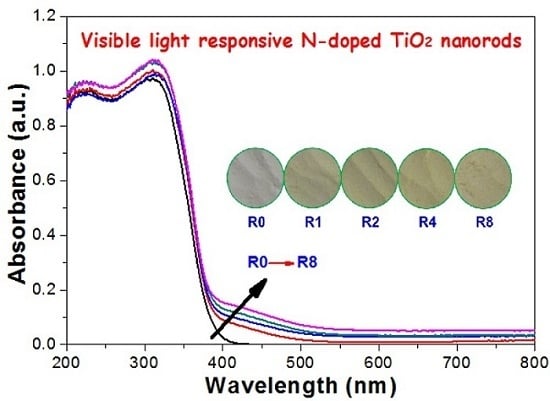Thiourea-Modified TiO2 Nanorods with Enhanced Photocatalytic Activity
Abstract
:1. Introduction
2. Results and Discussion
2.1. XRD
| Sample | R a | Pore Volume (cm3·g−1) | Average Pore Size (nm) | SBET (m2·g−1) | Average Crystalline Size (nm) | Relative Crystallinity b |
|---|---|---|---|---|---|---|
| R0 | 0 | 0.095 | 10.6 | 35.9 | 22.2 | 1 |
| R1 | 1 | 0.082 | 10.5 | 31.5 | 25.0 | 1.37 |
| R2 | 2 | 0.114 | 12.7 | 35.8 | 25.8 | 1.69 |
| R4 | 4 | 0.107 | 13.4 | 32.0 | 22.9 | 1.17 |
| R8 | 8 | 0.097 | 11.4 | 34.2 | 22.9 | 1.21 |
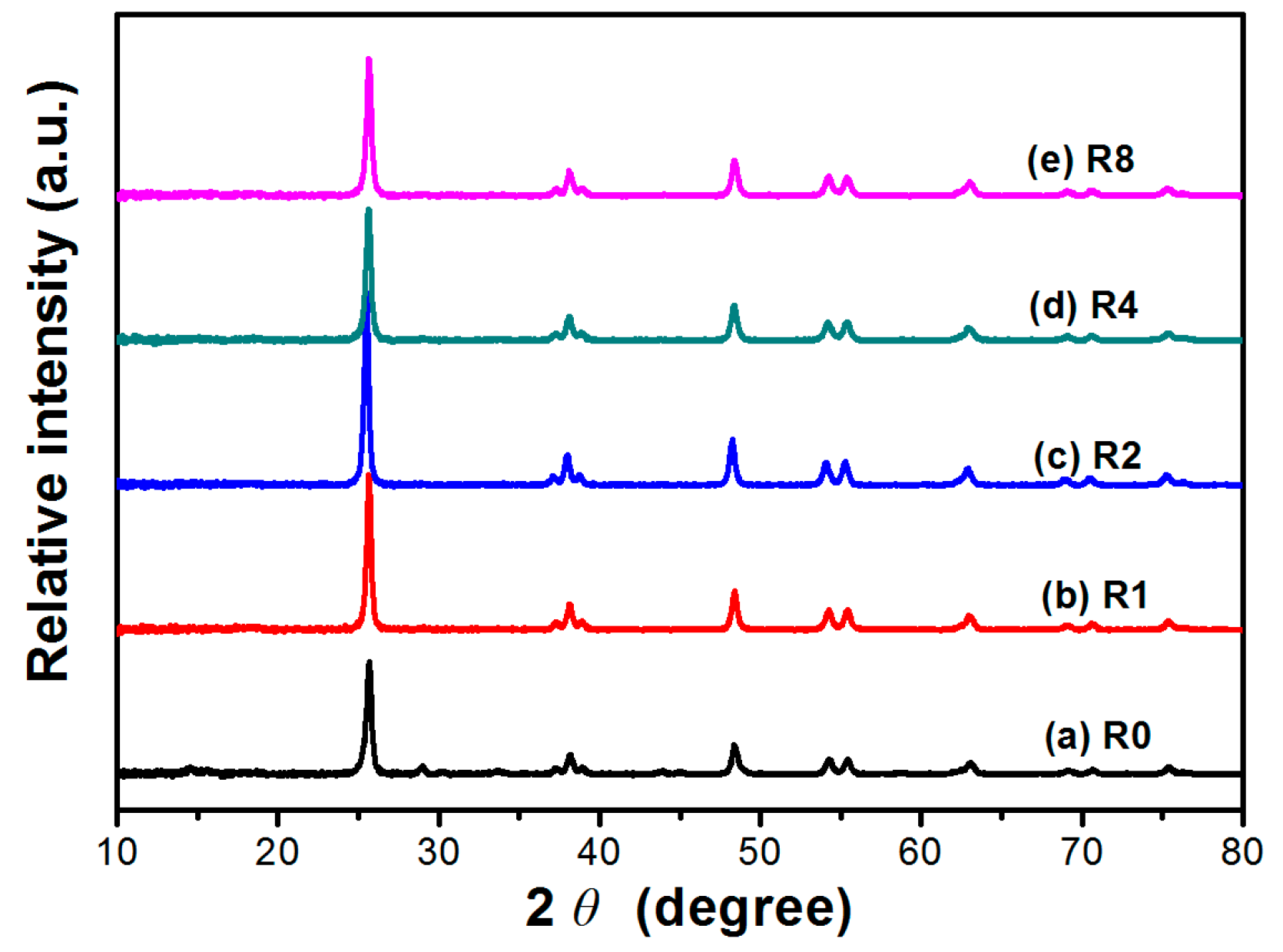
2.2. Morphology of Titanates
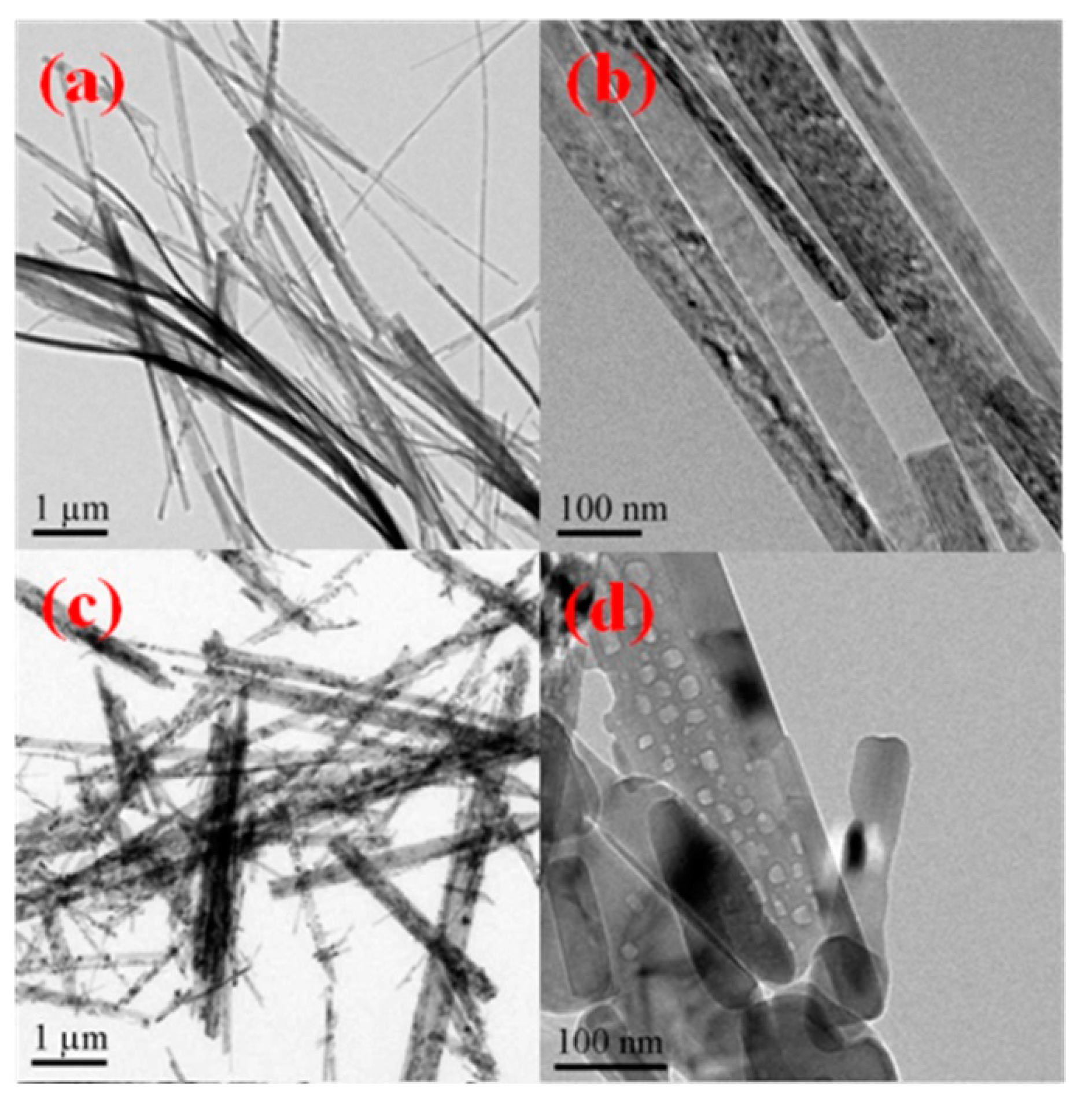
2.3. Morphology of Thiourea-Modified TiO2 Nanorods
2.4. Diffused Reflectance Spectroscopy
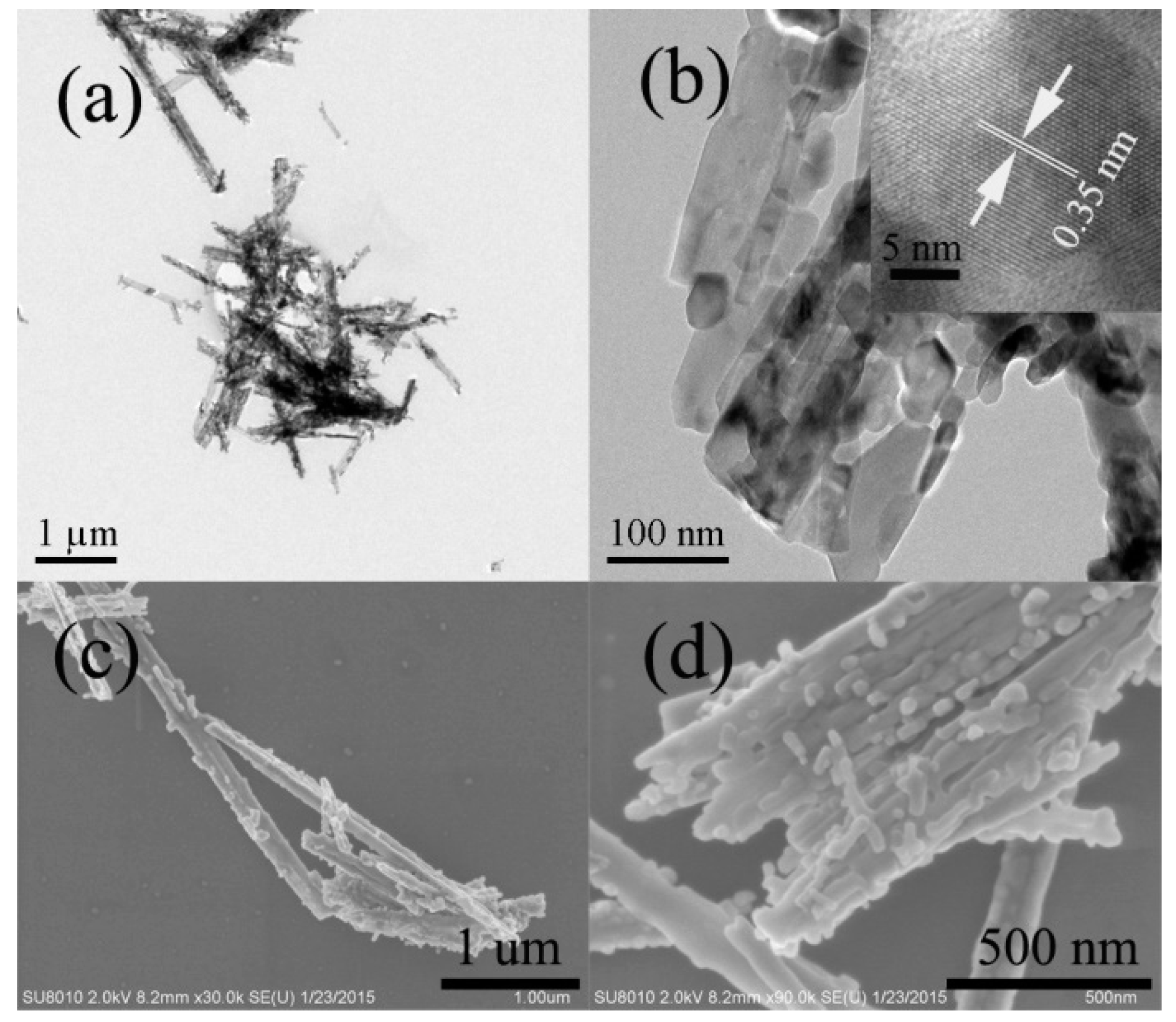
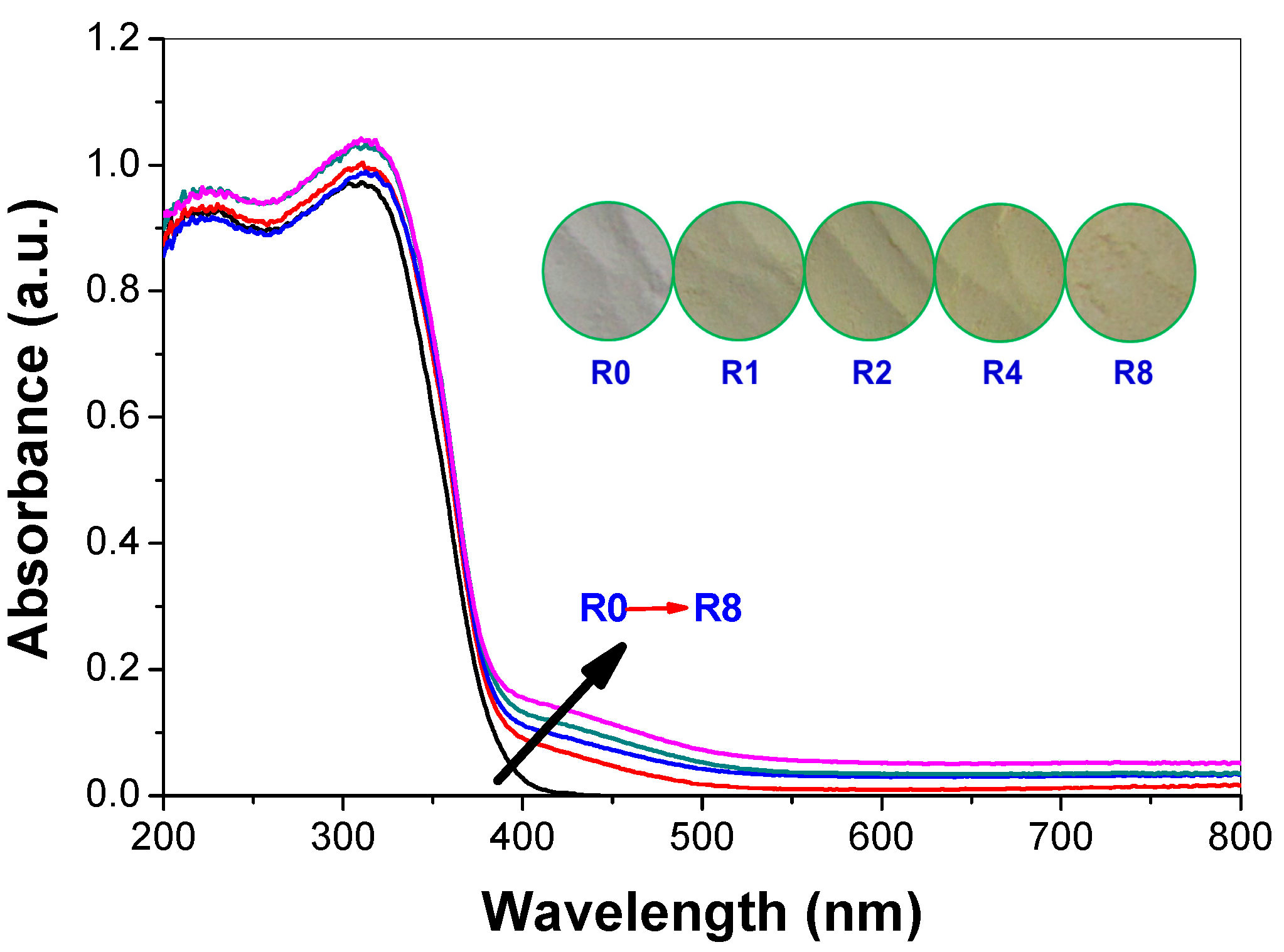
2.5. XPS Analysis
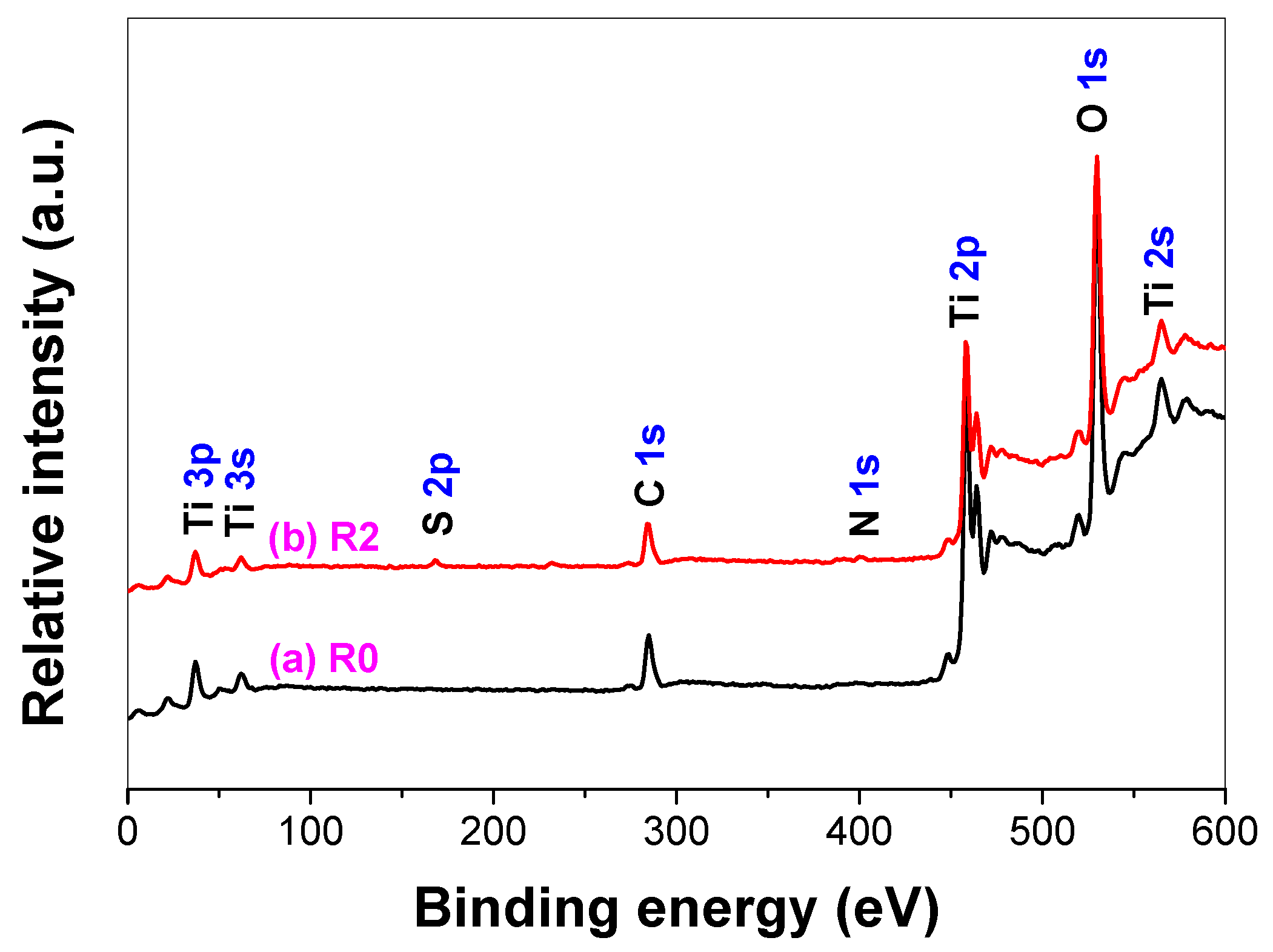
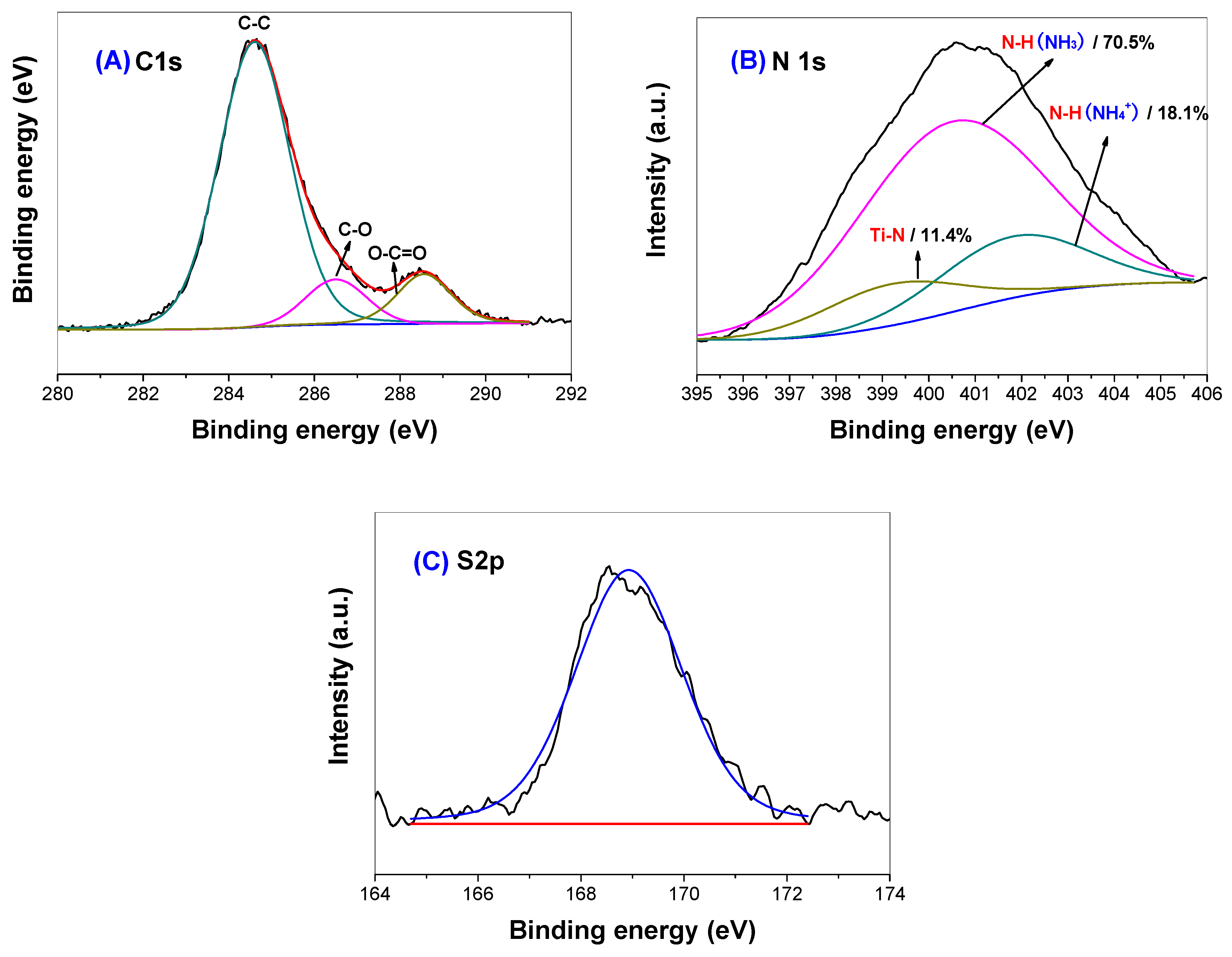
| Sample | Molar Ratio | |||
|---|---|---|---|---|
| C/Ti | N/Ti | S/Ti | O/Ti | |
| R0 | 2.85 | - | - | 2.74 |
| R2 | 2.02 | 0.079 | 0.106 | 3.28 |
| R8 | 3.69 | 0.103 | 0.123 | 3.81 |
2.6. Nitrogen Adsorption
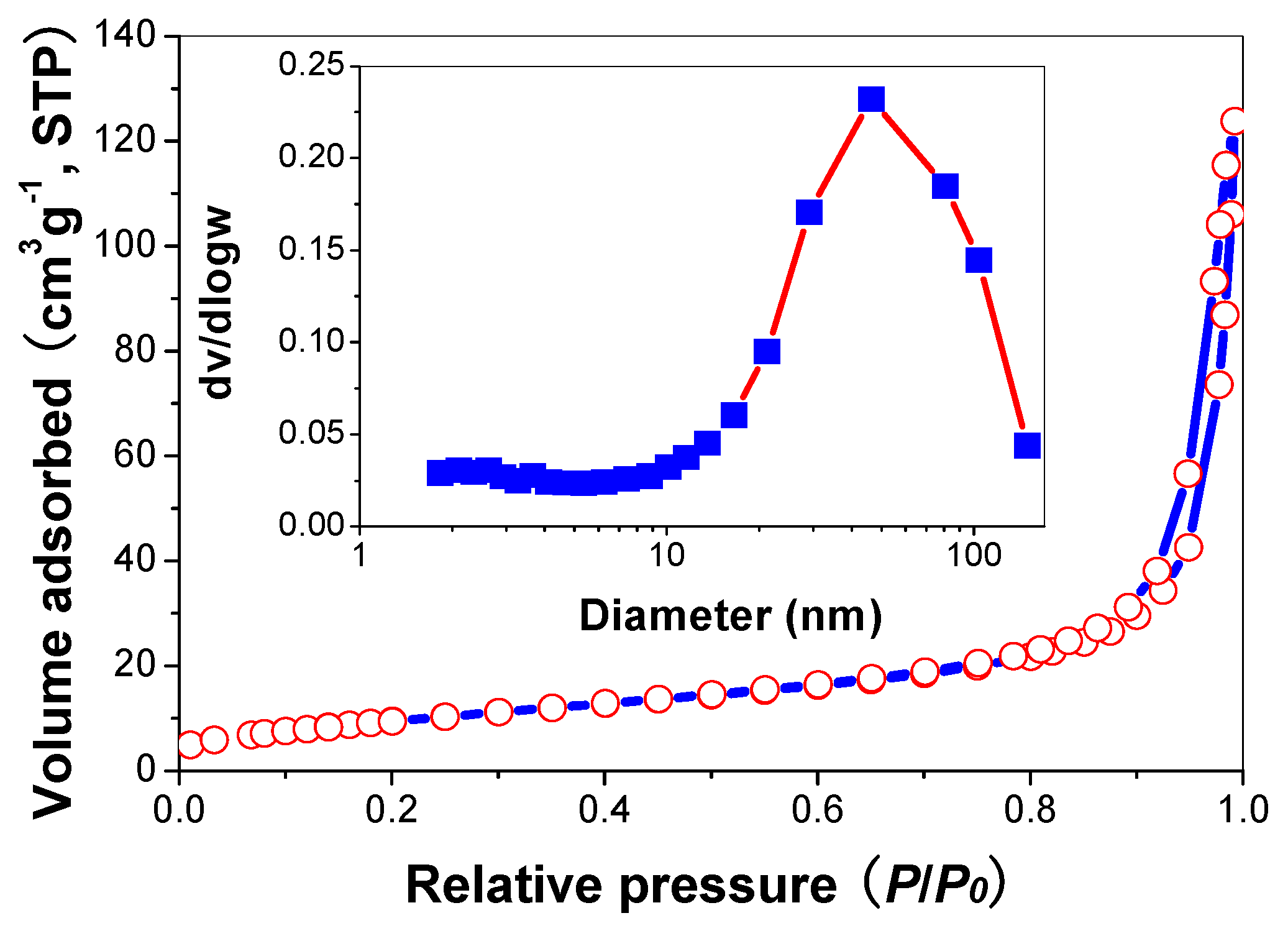
2.7. Photocatalytic Activity
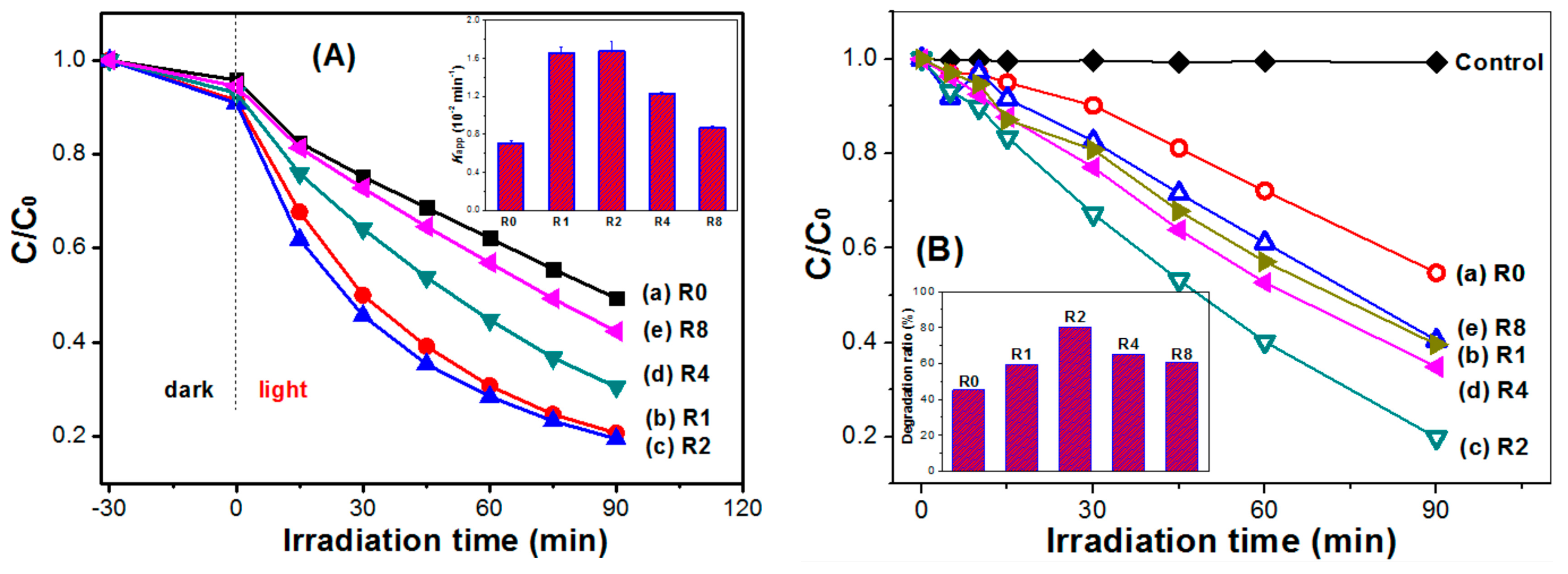
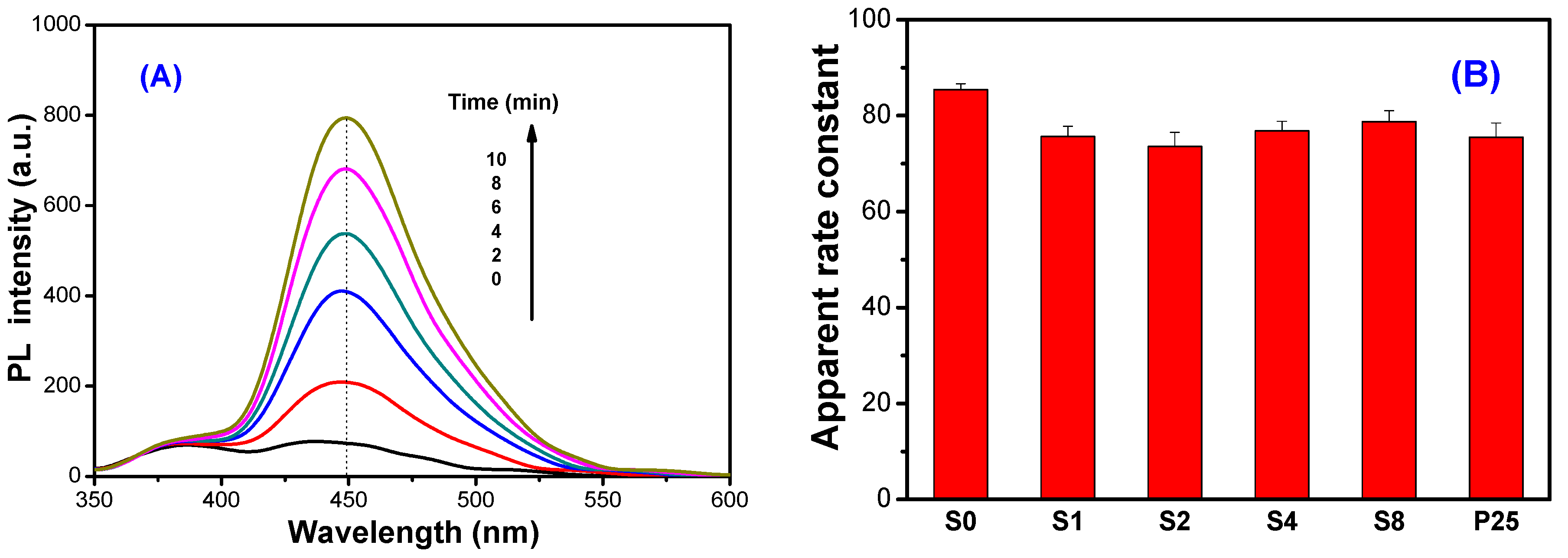
2.8. Photoluminescence Spectrum Analysis
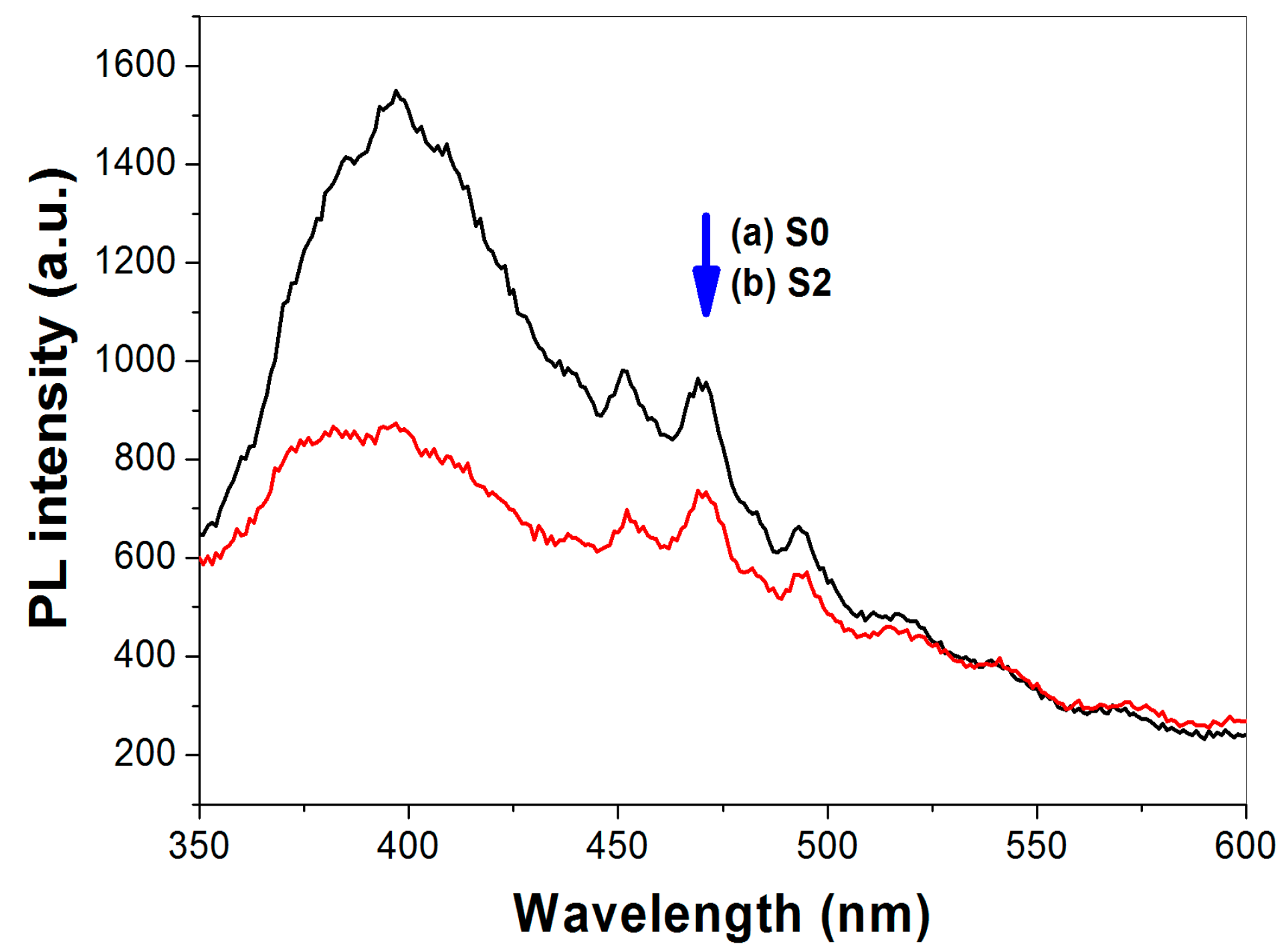
2.9. Photocurrent Response
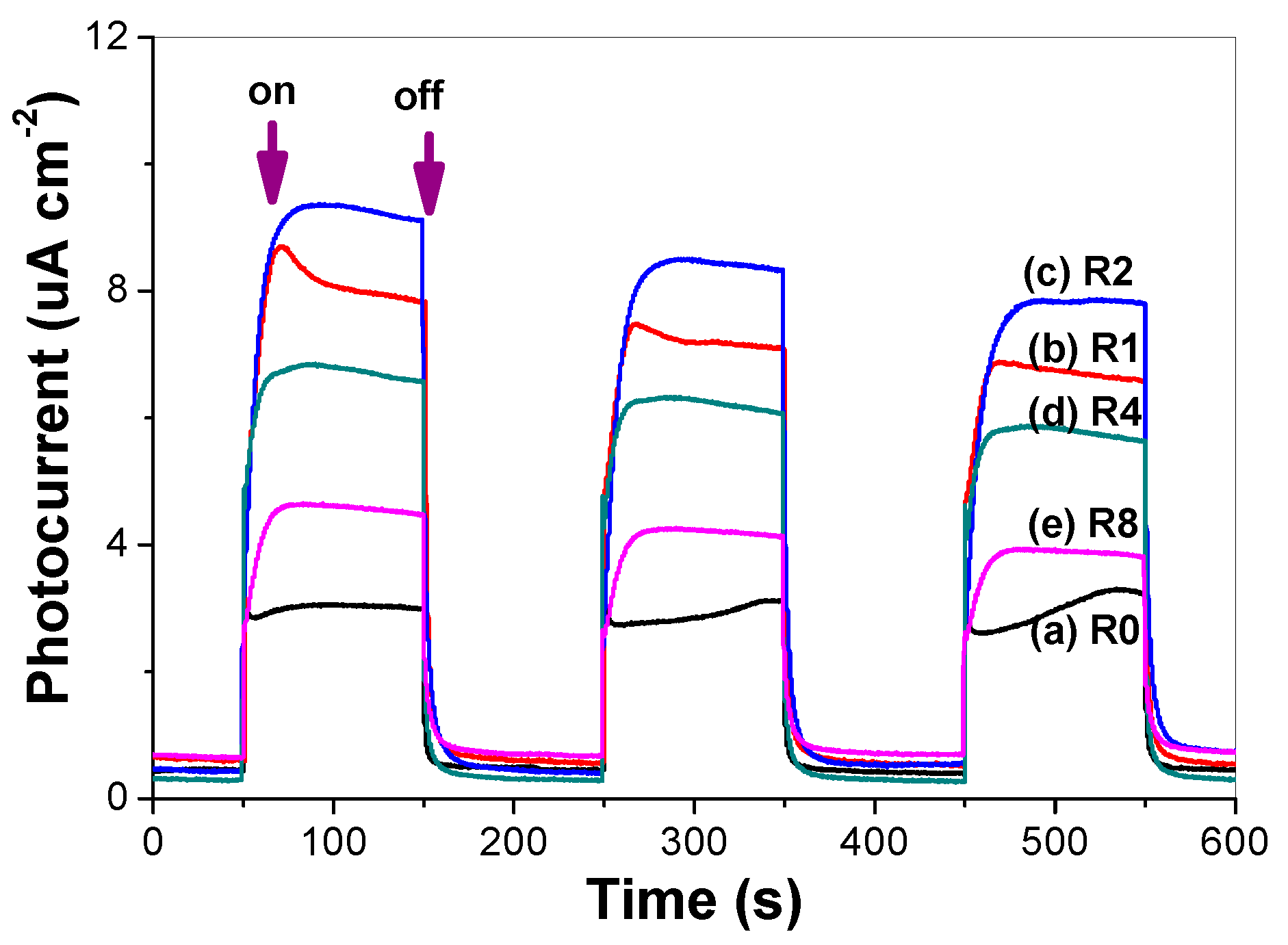
3. Experimental Section
3.1. Preparation
3.1.1. Titanates
3.1.2. TiO2 Nanorods Precursors
3.1.3. N-doped TiO2 Nanorods
3.2. Characterization
3.3. Photocatalytic Activity
3.3.1. Visible Photoctalytic Activity
3.3.2. UV Photocatalytic Activity
3.4. Photocurrent
4. Conclusions
Acknowledgments
Author Contributions
Conflicts of Interest
References
- Yu, J.G.; Low, J.X.; Xiao, W.; Zhou, P.; Jaroniec, M. Enhanced photocatalytic CO2-reduction activity of anatase TiO2 by coexposed {001} and {101} facets. J. Am. Chem. Soc. 2014, 136, 8839–8842. [Google Scholar] [CrossRef] [PubMed]
- Schneider, J.; Matsuoka, M.; Takeuchi, M.; Zhang, J.L.; Horiuchi, Y.; Anpo, M.; Bahnemann, D.W. Understanding TiO2 photocatalysis: Mechanisms and materials. Chem. Rev. 2014, 114, 9919–9986. [Google Scholar] [CrossRef]
- Yang, D.J.; Liu, H.W.; Zheng, Z.F.; Yuan, Y.; Zhao, J.C.; Waclawik, E.R.; Ke, X.B.; Zhu, H.Y. An efficient photocatalyst structure: TiO2(B) nanofibers with a shell of anatase nanocrystals. J. Am. Chem. Soc. 2005, 131, 17885–17893. [Google Scholar] [CrossRef] [PubMed]
- Liu, Y.; Chen, L.F.; Hu, J.C.; Li, J.L.; Richards, R. TiO2 nanoflakes modified with gold nanoparticles as photocatalysts with high activity and durability under near UV irradiation. J. Phys. Chem. C 2010, 114, 1641–1645. [Google Scholar] [CrossRef]
- Lv, K.L.; Cheng, B.; Yu, J.G.; Liu, G. Fluorine ions-mediated morphology control of anatase TiO2 with enhanced photocatalytic activity. Phys. Chem. Chem. Phys. 2012, 14, 5349–5362. [Google Scholar] [CrossRef] [PubMed]
- Pelaez, M.; Nolan, N.T.; Pillai, S.C.; Seery, M.K.; Falaras, P.; Kontos, A.G.; Dunlop, P.S.M.; Hamilton, J.W.J.; Byrne, J.A.; O’Shea, K.; et al. A review on the visible light active titanium dioxide photocatalysts for environmental applications. Appl. Catal. B Environ. 2012, 125, 331–349. [Google Scholar] [CrossRef]
- Xu, Y.M.; Lv, K.L.; Xiong, Z.G.; Leng, W.H.; Du, W.P.; Liu, D.; Xue, X.J. Rate enhancement and rate inhibition of phenol degradation over irradiated anatase and rutile TiO2 on the addition of naf: New insight into the mechanism. J. Phys. Chem. C 2007, 111, 19024–19032. [Google Scholar] [CrossRef]
- Sun, Q.; Xu, Y.M. Evaluating intrinsic photocatalytic activities of anatase and rutile TiO2 for organic degradation in water. J. Phys. Chem. C 2010, 114, 18911–18918. [Google Scholar] [CrossRef]
- Liu, Y.B.; Zhou, B.X.; Li, J.H.; Gan, X.J.; Bai, J.; Cai, W.M. Preparation of short, robust and highly ordered TiO2 nanotube arrays and their applications as electrode. Appl. Catal. B 2009, 92, 326–332. [Google Scholar] [CrossRef]
- Sun, J.; Yan, X.; Lv, K.L.; Sun, S.; Deng, K.J.; Du, D.Y. Photocatalytic degradation pathway for azo dye in TiO2/UV/O3 system: Hydroxyl radical versus hole. J. Mol. Catal. A 2013, 367, 31–37. [Google Scholar] [CrossRef]
- Mollavali, M.; Falamaki, C.; Rohani, S. Preparation of multiple-doped TiO2 nanotube arrays with nitrogen, carbon and nickel with enhanced visible light photoelectrochemical activity via single-step anodization. Int. J. Hydrog. Energy 2015, 40, 12239–12252. [Google Scholar] [CrossRef]
- Li, J.M.; Xu, D.S. Tetragonal faceted-nanorods of anatase TiO2 single crystals with a large percentage of active {100} facets. Chem. Commun. 2010, 46, 2301–2303. [Google Scholar]
- Yu, H.G.; Yu, J.G.; Cheng, B.; Lin, J. Synthesis, characterization and photocatalytic activity of mesoporous titania nanorod/titanate nanotube composites. J. Hazard. Mater. 2007, 147, 581–587. [Google Scholar] [CrossRef] [PubMed]
- Yu, J.G.; Xiang, Q.J.; Zhou, M.H. Preparation, characterization and visible-light-driven photocatalytic activity of Fe-doped titania nanorods and first-principles study for electronic structures. Appl. Catal. B 2009, 90, 595–602. [Google Scholar] [CrossRef]
- Kim, H.S.; Lee, J.W.; Yantara, N.; Boix, P.P.; Kulkarni, S.A.; Mhaisalkar, S.; Gratzel, M.; Park, N.G. High efficiency solid-state sensitized solar cell-based on submicrometer rutile TiO2 Nanorod and CH3NH3PbI3 perovskite sensitizer. Nano Lett. 2013, 13, 2412–2417. [Google Scholar] [CrossRef] [PubMed]
- Mao, Y.B.; Wong, S.S. Size- and Shape-dependent transformation of nanosized titanate into analogous anatase titania nanostructures. J. Am. Chem. Soc. 2006, 128, 8217–8226. [Google Scholar] [CrossRef] [PubMed]
- Yuan, R.S.; Fu, X.Z.; Wang, X.C.; Liu, P.; Wu, L.; Xu, Y.M.; Wang, X.X.; Wang, Z.Y. Template synthesis of hollow metal oxide fibers with hierarchical architecture. Chem. Mater. 2006, 18, 4700–4705. [Google Scholar] [CrossRef]
- Wang, F.C.; Liu, C.H.; Liu, C.W.; Chao, J.H.; Lin, C.H. Effect of Pt loading order on photocatalytic activity of Pt/TiO2 nanofiber in generation of H2 from neat ethanol. J. Phys. Chem. C 2009, 113, 13832–13840. [Google Scholar] [CrossRef]
- Cao, T.P.; Li, Y.J.; Wang, C.H.; Shao, C.L.; Liu, Y.C. A facile in situ hydrothermal method to SrTiO3/TiO2 nanofiber heterostructures with high photocatalytic activity. Langmuir 2011, 27, 2946–2952. [Google Scholar] [CrossRef] [PubMed]
- Formo, E.; Lee, E.; Campbell, D.; Xia, Y. Functionalization of electrospun TiO2 nanofibers with pt nanoparticles and nanowires for catalytic applications. Nano Lett. 2008, 8, 668–672. [Google Scholar]
- Asahi, F.; Morikawa, T.; Ohwaki, T.; Aoki, K.; Taga, Y. Visible-light photocatalysis in nitrogen-doped titanium oxides. Science 2001, 293, 269–271. [Google Scholar] [CrossRef] [PubMed]
- Zheng, R.Y.; Guo, Y.; Jin, C.; Xie, J.L.; Zhu, Y.X.; Xie, Y.C. Novel thermally stable phosphorus-doped TiO2 photocatalyst synthesized by hydrolysis of TiCl4. J. Mol. Catal. A 2010, 319, 46–51. [Google Scholar] [CrossRef]
- Xiang, Q.J.; Yu, J.G.; Jaroniec, M. Nitrogen and sulfur co-doped TiO2 nanosheets with exposed {001} facets: Synthesis, characterization and visible-light photocatalytic activity. Phys. Chem. Chem. Phys. 2011, 13, 4853–4861. [Google Scholar] [CrossRef] [PubMed]
- Si, L.L.; Huang, Z.A.; Lv, K.L.; Tang, D.G.; Yang, C.J. Facile preparation of Ti3+ self-doped TiO2 nanosheets with dominant {001} facets using zinc powder as reductant. J. Alloys Compd. 2014, 601, 88–93. [Google Scholar] [CrossRef]
- Yu, J.G.; Li, Q.; Liu, S.W.; Jaroniec, M. Ionic-liquid-assisted synthesis of uniform fluorinated B/C-codoped TiO2 nanocrystals and their enhanced visible-light photocatalytic activity. Chem. Eur. J. 2013, 19, 2433–2441. [Google Scholar] [CrossRef] [PubMed]
- Cai, J.H.; Huang, Z.A.; Lv, K.L.; Sun, J.; Deng, K.J. Ti powder-assisted synthesis of Ti3+ self-doped TiO2 nanosheets with enhanced visible-light photoactivity. RSC Adv. 2014, 4, 19588–19593. [Google Scholar] [CrossRef]
- Liu, G.; Yang, H.G.; Wang, X.W.; Cheng, L.; Pan, J.; Lu, G.Q.; Cheng, H.M. Visible light responsive nitrogen doped anatase TiO2 sheets with dominant {001} facets derived from TiN. J. Am. Chem. Soc. 2009, 131, 12868–12869. [Google Scholar] [CrossRef] [PubMed]
- Manthina, V.; Agrios, A.G. Band edge engineering of composite photoanodes for dye-sensitized solar cells. Electrochim. Acta 2015, 169, 416–423. [Google Scholar] [CrossRef]
- Lv, K.L.; Zuo, H.S.; Sun, J.; Deng, K.J.; Liu, S.C.; Li, X.F.; Wang, D.Y. (Bi, C and N) codoped TiO2 nanoparticles. J. Hazard. Mater. 2009, 161, 396–401. [Google Scholar] [CrossRef] [PubMed]
- Lv, K.L.; Hu, J.C.; Li, X.H.; Li, M. Cysteine modified anatase TiO2 hollow microspheres with enhanced visible-light-driven photocatalytic activity. J. Mol. Catal. A 2012, 356, 78–84. [Google Scholar] [CrossRef]
- Zhang, G.S.; Zhang, Y.C.; Nadagouda, M.; Han, C.; O’Shea, K.; El-Sheikh, S.M.; Ismail, A.A.; Dionysiou, D.D. Visible light-sensitized S, N and C co-doped polymorphic TiO2 forphotocatalytic destruction of microcystin-LR. Appl. Catal. B Environ. 2014, 144, 614–621. [Google Scholar] [CrossRef]
- Zhang, L.W.; Fu, H.B.; Zhu, Y.F. Efficient TiO2 photocatalysts from surface hybridization of TiO2 particles with graphite-like carbon. Adv. Funct. Mater. 2008, 18, 2180–2189. [Google Scholar] [CrossRef]
- Periyat, P.; Pillai, S.C.; McCormack, D.E.; Colreavy, J.C.; Hinder, S.J. Improved high-temperature stability and sun-light-driven photocatalytic activity of sulfur-doped anatase TiO2. J. Phys. Chem. C 2008, 112, 7644–7652. [Google Scholar] [CrossRef]
- Wang, J.; Tafen, D.N.; Lewis, J.P.; Hong, Z.L.; Manivannan, A.; Zhi, M.J.; Li, M.; Wu, N.Q. Origin of photocatalytic activity of nitrogen-doped TiO2 nanobelts. J. Am. Chem. Soc. 2009, 131, 12290–12297. [Google Scholar] [CrossRef] [PubMed]
- Yu, J.G.; Su, Y.R.; Cheng, B. Template-free fabrication and enhanced photocatalytic activity of hierarchical macro-/mesoporous titania. Adv. Funct. Mater. 2007, 17, 1984–1990. [Google Scholar] [CrossRef]
- Xu, Y.M.; Langford, C.H. UV- or visible-light-induced degradation of X3B on TiO2 nanoparticles: The influence of adsorption. Langmuir 2001, 17, 897–902. [Google Scholar] [CrossRef]
- Lin, Y.-C.; Chien, T.E.; Lai, P.C.; Chiang, Y.H.; Li, K.L.; Lin, J.L. TiS2 transformation into S-doped and N-doped TiO2 with visible-light catalytic activity. Appl. Surf. Sci. 2015, 359. [Google Scholar] [CrossRef]
- Lv, K.L.; Yu, J.G.; Deng, K.J.; Li, X.H.; Li, M. Effect of phase structures on the formation rate of hydroxyl radicals on the surface of TiO2. J. Phys. Chem. Solids 2010, 71, 519–522. [Google Scholar] [CrossRef]
- Wang, Z.Y.; Lv, K.L.; Wang, G.H.; Deng, K.J.; Tang, D.G. Study on the shape control and photocatalytic activity of high-energy anatase titania. Appl. Catal. B 2010, 100, 378–385. [Google Scholar] [CrossRef]
- Huang, Z.A.; Wang, Z.Y.; Lv, K.L.; Zheng, Y.; Deng, K.J. Transformation of TiOF2 cube to a hollow nanobox assembly from anatase TiO2 nanosheets with exposed {001} facets via solvothermal strategy. ACS Appl. Mater. Interfaces 2013, 5, 8663–8669. [Google Scholar] [CrossRef] [PubMed]
- Huang, Z.A.; Sun, Q.; Lv, K.L.; Zhang, Z.H.; Li, M.; Li, B. Effect of contact interface between TiO2 and g-C3N4 on the photoreactivity of g-C3N4/TiO2 photocatalyst: (001) vs. (101) facets of TiO2. Appl. Catal. B 2015, 164, 420–427. [Google Scholar] [CrossRef]
- Zhu, H.Y.; Lan, Y.; Gao, X.P.; Ringer, S.P.; Zheng, Z.F.; Song, D.Y.; Zhao, J.C. Phase transition between nanostructures of titanate and titanium dioxides via simple wet-chemical reactions. J. Am. Chem. Soc. 2005, 127, 6730–6736. [Google Scholar] [CrossRef] [PubMed]
- Lv, K.L.; Xu, Y.M. Effects of Polyoxometalate and fluoride on adsorption and photocatalytic degradation of organic dye X3B on TiO2: The difference in the production of reactive species. J. Phys. Chem. B 2006, 110, 6204–6212. [Google Scholar] [CrossRef] [PubMed]
- Lan, J.F.; Wu, X.F.; Lv, K.L.; Si, L.L.; Deng, K.J. Fabrication of TiO2 hollow microspheres using K3PW12O40 as template. Chin. J. Catal. 2015, 36, 2237–2243. [Google Scholar] [CrossRef]
- Zheng, Y.; Cai, J.H.; Lv, K.L.; Sun, J.; Ye, H.P.; Li, M. Hydrogen peroxide assisted rapid synthesis of TiO2 hollow microspheres with enhanced photocatalytic activity. Appl. Catal. B 2014, 147, 789–795. [Google Scholar] [CrossRef]
- Sample Availability: Samples of the N-doped TiO2 nanorods are available from the authors.
© 2016 by the authors. Licensee MDPI, Basel, Switzerland. This article is an open access article distributed under the terms and conditions of the Creative Commons by Attribution (CC-BY) license ( http://creativecommons.org/licenses/by/4.0/).
Share and Cite
Wu, X.; Fang, S.; Zheng, Y.; Sun, J.; Lv, K. Thiourea-Modified TiO2 Nanorods with Enhanced Photocatalytic Activity. Molecules 2016, 21, 181. https://doi.org/10.3390/molecules21020181
Wu X, Fang S, Zheng Y, Sun J, Lv K. Thiourea-Modified TiO2 Nanorods with Enhanced Photocatalytic Activity. Molecules. 2016; 21(2):181. https://doi.org/10.3390/molecules21020181
Chicago/Turabian StyleWu, Xiaofeng, Shun Fang, Yang Zheng, Jie Sun, and Kangle Lv. 2016. "Thiourea-Modified TiO2 Nanorods with Enhanced Photocatalytic Activity" Molecules 21, no. 2: 181. https://doi.org/10.3390/molecules21020181
APA StyleWu, X., Fang, S., Zheng, Y., Sun, J., & Lv, K. (2016). Thiourea-Modified TiO2 Nanorods with Enhanced Photocatalytic Activity. Molecules, 21(2), 181. https://doi.org/10.3390/molecules21020181






